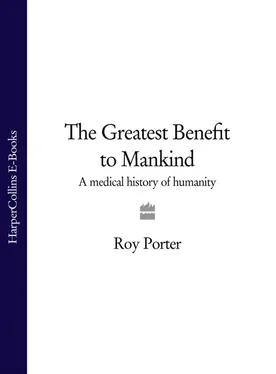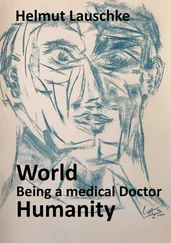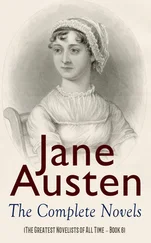Anatomists presented their subject as the cutting edge; the way to certain knowledge was through the senses, especially by ‘autopsia’, seeing for oneself. Though the Paduan Aristotelian philosopher Cesare Cremonini (1552–1631) was still insisting in 1627 that anatomy could never be the foundation of medicine (only causes, the domain of philosophy, and not observation could lead to certainty), the sheer success of anatomy swept this dogma aside. Dissections became public events: at Bologna they were staged during the annual carnival, the macabre fascination of the memento mori, juxtaposing life and death, contributing to the appeal. Rembrandt’s ‘The Anatomy Lesson of Dr Nicolaes Tulp’ (1632), shows that anatomy had become one of the spectacles and symbols of the age. Not only the method of medicine, anatomy became accepted as a window onto the human condition.
Surgery saw fewer significant changes, and still played second fiddle to physic, being relatively unaffected by the new anatomy. Restricted largely to the body’s surface, surgeons dealt with the many accidents of life. They set fractures, treated burns, contusions, knife wounds and the increasingly common gunshot wounds, tumours and swellings, ulcers and various skin diseases; syphilis was usually handled as a surgical condition. Surgery was seen as a skilled craft: ‘A chirurgien should have three divers properties in his person,’ judged John Halle (1529–68), ‘that is to say, a heart as the heart of a lion, his eye like the eyes of an hawk, and his hands as the hands of a woman.’
Through most of Europe, surgery continued to be taught by apprenticeship and organized in guilds. In London a master surgeons’ guild had been founded in 1368; the Mystery or Guild of the Barbers of London received its charter from Edward IV in 1462; and in 1540, by Act of Parliament, the Guild of Surgeons merged with the Barbers to form the Barber-Surgeons Company, its first master being Thomas Vicary (c. 1490–1561); Holbein painted Henry VIII chartering the company, which continued until 1745. An active member was William Clowes (1544–1603), who worked as a naval surgeon before setting up in practice in London and being appointed surgeon at St Bartholomew’s Hospital in 1575. Military operations in the Low Countries (1586) gave him ample experience, and in 1588 he was appointed surgeon to the fleet. Clowes’s treatises on wounds, venereal disease and scrofula were written in racy vernacular, with young surgeons in mind, presenting personal case histories.
Clowes was one of a line of able common-or-garden surgeons: John Woodall’s (1556–1643) The Surgeon’s Mate (1617) served as a manual of naval surgery, attacking the bad habits of ‘blaspheming the name of the Almighty’ and the ‘dedication to the pot and Tobacco-pipe’ which were all too common among apprentices; Richard Wiseman (1621–76) was honoured as the ‘father of English surgery’. His Several Chirurgical Treatises (1676) dwelt on military and naval problems, while his Treatise of Wounds (16 j 2), jocularly known as Wiseman’s Book of Martyrs, advertised itself as specially for ships’ doctors ‘who seldom burden their cabin with many books’. He picked up much of his experience during the English Civil War, and his account of military surgery reveals its horrors: cannonballs and gunshot caused horrifying wounds, and amputation and trepanation were often the only remedies, conducted on the battlefield or on a storm-tossed vessel.
Fabricius left a graphic description of a sixteenth-century amputation:
I was about to cut off the thigh of a man of forty yeares of age, and ready to use the saw, and Cauteries. For the sick man no sooner began to roare out, but all ranne away, except only my eldest Sonne, who was then but little, and to whom I had committed the holding of his thigh, for forme only; and but that my wife then great with child, came running out of the next chamber, and clapt hold of the Patient’s Thorax, both he and myselfe had been in extreme danger.
This may not have been an uncommon scene before anaesthesia was available.
‘He who wishes to be a surgeon should go to war,’ Hippocrates had advised, and the battlefield became accepted as the school of surgery. Growing use of gunpowder had worsened the injuries confronting field-surgeons, because cannonballs and lead shot destroyed far more tissue than arrows or swords and left gaping wounds prone to infection. Many of the most popular vernacular handbooks, such as the Buch der Wund-Artzney (1497) [Book of Wound Dressing] of Hieronymus Brunschwig (1450–1533) and the Feldbuch der Wundartzney (1517) [Fieldbook of Wound Dressing] of Hans von Gersdorff (c. 1455–1529), were based on field experience. Brunschwig’s work contains the earliest printed illustrations of surgical instruments, and endorsed the view that shot wounds were poisoned by gunpowder and so required cautery. Gersdorff explained how to extract bullets with special instruments and dress wounds with hot oil. Amputated stumps were to be enclosed in an animal bladder, after controlling haemorrhage by pressure and styptics. Thomas Gale (1507–87) published An Excellent Treatise of Wounds made with Gonneshot (1563) – the first English work on the subject.
The most acclaimed Renaissance surgeon, Ambroise Paré (1510–90), also learned his craft through war. In 1533 he served as aide-chirurgien to the chief Paris hospital, the Hôtel Dieu; and from 1537, for almost thirty years, he divided his time between tending the Paris sick and following the army. Enrolled in 1554 into the confraternity of St Côme, the surgeons’ college, five years later Paré attempted in vain to save the life of Henri II after he had been wounded in a jousting tournament.
Paré gave a conventional account of the ‘five duties’ of his art: ‘to remove what is superfluous, to restore what has been dislocated, to separate what has grown together, to reunite what has been divided and to redress the defects of nature’. His prime innovation lay in rejection of the standard treatments for gunshot wounds: the use of cautery (the burning iron) or scalding oil (‘potential cautery’) to destroy poison and forestall putrefaction before beginning restorative therapy. In his La methode de traicter leys playes faictes par hacquebutes et aultres bastons à feu (1545) [Treatise on Gunshot Wounds], he described how, as a greenhorn on campaign in Italy in 1537, he had been forced to innovate. Initially, as taught, he had used boiling oil on what were considered to be poisonous gunpowder wounds:
But my oil ran out and I had to apply a healing salve made of egg-white, rose-oil and turpentine. The next night I slept badly, plagued by the thought that I would find the men dead whose wounds I had failed to burn, so I got up early to visit them. To my great surprise, those treated with salve felt little pain, showed no inflammation or swelling, and had passed the night rather calmly – while the ones on which seething oil had been used lay in high fever with aches, swelling and inflammation around the wound.
At this, I resolved never again cruelly to burn poor people who had suffered shot wounds.
Thenceforth he relied on restorative methods, using a digestive (wound-dressing) made of egg, oil of roses and turpentine, justifying this on the supposition that the gunpowder and shot were not, after all, poisonous. Piously, he always said that he had dressed the wound but God had healed the patient: Je le pansay; Dieu le guarit.
Another innovation mentioned in his Dix livres de la chirurgie (1564) [Ten Books of Surgery] was the use of ligatures in conducting amputations. Other writers had recommended tying off the veins and arteries so as to stop the blood, but Paré worked out the practical details. This made successful thigh amputations possible – William Clowes reported performing one in 1588, as did Fabricius a little later. There was, however, one drawback. No fewer than fifty-three ligatures were necessary in a thigh amputation, and this required trained assistance. Consequently, ligatures could come into general use only after a method had been found to control blood flow until the surgeon could tie the blood vessels, something accomplished in eighteenth-century France when J. L. Petit invented the first effective tourniquet.
Читать дальше












